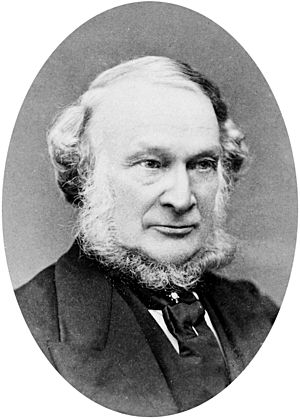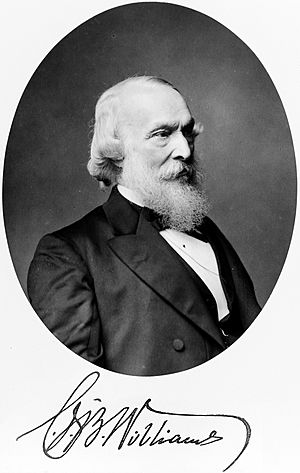Charles James Blasius Williams facts for kids
Charles James Blasius Williams (born February 3, 1805 – died March 24, 1889) was an important English doctor. He was one of the first to use new ways to check patients, especially for problems with their chest. He became very well known for his knowledge of diseases of the chest.
Contents
Life of a Pioneer Doctor
Early Life and Education
Charles James Blasius Williams was born in 1805 in Hungerford, England. He was the eighth child of Reverend David Williams. His father, who was a private tutor, taught him at home. In 1820, Charles went to the University of Edinburgh to study medicine. He earned his medical degree (M.D.) in 1824. His special project for his degree was about blood and how it changes when we breathe.
Learning New Medical Skills
After finishing his studies, Williams traveled to Paris in 1825. There, he learned from a famous doctor named René Laennec. Laennec had invented the stethoscope, a tool doctors use to listen to sounds inside the body. Williams quickly learned how to use the stethoscope and became very skilled at listening to hearts and lungs. He was one of the first British doctors to use this new method, called auscultation, and he even improved on Laennec's ideas.
In 1827, he returned to London. He married Harriet Williams Jenkins in 1830.
Becoming a Leading Physician
Williams started his own medical practice in London. In 1835, he was chosen to be a Fellow of the Royal Society, which is a very respected group of scientists. He also gave lectures on chest diseases. In 1839, he became a professor of medicine at University College London.
He was elected a fellow of the College of Physicians of London in 1840. Williams wanted to make changes to how the College worked, showing he was a forward-thinking person in medicine.
Helping Found a Hospital
In 1841, Williams helped start the Consumption Hospital in Brompton. This hospital was very important for treating people with lung diseases. He continued to support it throughout his life. He also became the first president of the Pathological Society when it was formed in 1846. For many years, he was a top specialist in chest diseases. In 1874, he was even appointed as a special doctor to the Queen.
Retirement
In 1875, Williams stopped practicing medicine and moved to Cannes, a city in France. He passed away there on March 24, 1889.
Important Medical Works
Early Publications
Even as a student, Williams was publishing his ideas. In 1823, he wrote a paper about how candles burn. In 1828, he published an important book called Rational Exposition of the Physical Signs of the Diseases of the Lungs and Pleura. This book helped other doctors understand how to use physical signs to diagnose lung diseases. He also wrote many articles for medical books.
Research on Heart Sounds
In the early 1830s, Williams worked with another doctor, James Hope, to study heart sounds. They even studied donkeys to learn more! Both doctors published their findings, which helped advance medical knowledge.
Later Books and Autobiography
In 1843, Williams published a book called Principles of Medicine, which was very popular and had several editions. Later, in 1871, he worked with his son, Dr. Charles Theodore Williams, to write a book about pulmonary consumption, which is a serious lung disease.
In 1884, he wrote his autobiography, called Memoirs of Life and Work. This book told the story of his life and his important work in medicine.



